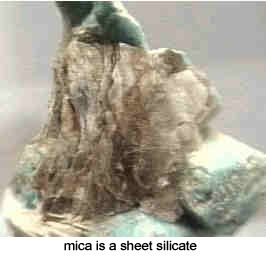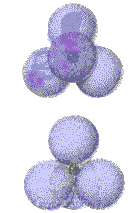BACKGROUND:
 Quartz
is a silicate mineral. All silicate minerals share the same basic
Quartz
is a silicate mineral. All silicate minerals share the same basic  building
block elements: silicon (Si) and oxygen (O) in the molecular configuration
SiO4. This compound is called silica and referred to as a silica
tetrahedron. as shown below. The large ball represents oxygen and the
smaller ball represents the silicon. These oxygen atoms define a tetrahedral
shape, with one oxygen atom at each points.
building
block elements: silicon (Si) and oxygen (O) in the molecular configuration
SiO4. This compound is called silica and referred to as a silica
tetrahedron. as shown below. The large ball represents oxygen and the
smaller ball represents the silicon. These oxygen atoms define a tetrahedral
shape, with one oxygen atom at each points.
Silicate minerals occur in a great variety because, in
addition to joining with other elements, silica tetrahedra can join with
each other, creating rings, chains, double chains, sheets, framework, and
other three dimensional silicate structures.
PROCEDURE:
- Students can discover just how many tetrahedra combinations are
possible. Each pyramid on the sheet represents a silica tetrahedron.
Have them cut out the separate silicon tetrahedron.
- Make them arrange the pyramids into a pattern that can repeat itself.
The different patterns would be equivalent to some type of silicate
minerals.
- If you have Googolpex, have the students construct three-dimensional
tetrahedron models. Have them point out where the oxygen and
silicon atoms are located. With both the Googolplex and paper models the
corners represent the oxygen atoms. The centrally located silicon atom
is not present, but tell the students to assume it is inside the
structure.
- Review the tetrahedra combinations made by the students. Explain that
these represent just a small portion of the many silicate minerals that
are present in the Earth’s crust. These make up the thousands of
silicate minerals.
"A" represents a sheet silicate; "B" represents a
chain silicate; "C" represents a single or double: and
"D" represents a ring silicate.